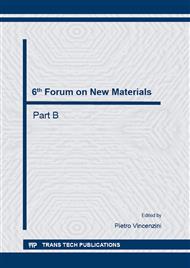[1]
M. Osaka, S. Miwa, Y. Tachi, Simple fabrication process for CeO2–MgO composite as surrogate for actinide-containing target for use in nuclear fuel, Ceramics International. 32 (2006) 659-663.
DOI: 10.1016/j.ceramint.2005.04.026
Google Scholar
[2]
Y. Croixmarie, E. Abonneau, A. Fernandez, R.J.M. Konings, F. Desmouliere, L. Donnet, Fabrication of transmutation fuels and targets: the ECRIX and CAMIX-COCHIX experience, Journal of Nuclear Materials. 320 (2003) 11-17.
DOI: 10.1016/s0022-3115(03)00162-4
Google Scholar
[3]
S. Pillon, J. Somers, S. Grandjean, J. Lacquement, Aspects of fabrication of curium-based fuels and targets, Journal of Nuclear Materials. 320 (2003) 36-43.
DOI: 10.1016/s0022-3115(03)00168-5
Google Scholar
[4]
W. Maschek, X. Chen, F. Delage, A. Femandez-Carretero, D. Haas, C.M. Boccaccini, A. Rineiski, P. Smith, V. Sobolev, R. Thetford, J. Wallenius, Accelerator driven systems for transmutation: Fuel development, design and safety, Progress in Nuclear Energy. 50 (2008).
DOI: 10.1016/j.pnucene.2007.11.066
Google Scholar
[5]
D.D. Sood, The role sol-gel process for nuclear fuels-an overview, Journal of Sol-Gel Science and Technology. 59 (2011) 404-416.
DOI: 10.1007/s10971-010-2273-y
Google Scholar
[6]
A. Fernandez, R.J.M. Konings, J. Somers, Design and fabrication of specific ceramic-metallic fuels and targets, Journal of Nuclear Materials. 319 (2003) 44-50.
DOI: 10.1016/s0022-3115(03)00132-6
Google Scholar
[7]
B. Ye, J.L. Miao, J.L. Li, Z.C. Zhao, Z.Q. Chang, C.A. Serra, Fabrication of size-controlled CeO2 microparticles by a microfluidic sol-gel process as an analog preparation of ceramic nuclear fuel, Journal of Nuclear Science and Technology. 50 (2013).
DOI: 10.1080/00223131.2013.796897
Google Scholar
[8]
Z.Q. Chang, C.A. Serra, M. Bouquey, L. Prat, G. Hadziioannou, Co-axial capillaries microfluidic device for synthesizing size- and morphology-controlled polymer core-polymer shell particles, Lab on a Chip. 9 (2009) 3007-3011.
DOI: 10.1039/b913703c
Google Scholar
[9]
C.A. Serra, Z.Q. Chang, Microfluidic-assisted synthesis of polymer particles, Chemical Engineering & Technology. 31 (2008) 1099-1115.
DOI: 10.1002/ceat.200800219
Google Scholar
[10]
E. Remy, S. Picart, S. Grandjean, T. Delahaye, N. Herlet, P. Allegri, O. Dugne, R. Podor, N. Clavier, P. Blanchart, A. Ayral, Calcined resin microsphere pelletization (CRMP): A novel process for sintered metallic oxide pellets, Journal of the European Ceramic Society. 32 (2012).
DOI: 10.1016/j.jeurceramsoc.2012.04.011
Google Scholar
[11]
Z.Q. Chang, C.A. Serra, M. Bouquey, I. Kraus, S.N. Li, J.M. Kohler, Multiscale materials from microcontinuous-flow synthesis: ZnO and Au nanoparticle-filled uniform and homogeneous polymer microbeads, Nanotechnology. 21 (2010).
DOI: 10.1088/0957-4484/21/1/015605
Google Scholar
[12]
C. Cramer, P. Fischer, E.J. Windhab, Drop formation in a co-flowing ambient fluid, Chemical Engineering Science. 59 (2004) 3045-3058.
DOI: 10.1016/j.ces.2004.04.006
Google Scholar
[13]
C. Serra, N. Berton, M. Bouquey, L. Prat, G. Hadziioannou, A predictive approach of the influence of the operating parameters on the size of polymer particles synthesized in a simplified microfluidic system, Langmuir. 23 (2007) 7745-7750.
DOI: 10.1021/la063289s
Google Scholar
[14]
B. Guo, Z.L. Liu, L. Hong, H.X. Jiang, J.Y. Lee, Photocatalytic effect of the sol-gel derived nanoporous TiO2 transparent thin films, Thin Solid Films. 479 (2005) 310-315.
DOI: 10.1016/j.tsf.2004.11.197
Google Scholar
[15]
J.G. Yu, J.C. Yu, B. Cheng, X.J. Zhao, Z. Zheng, A.S.K. Li, Atomic force microscopic studies of porous TiO2 thin films prepared by the sol-gel method, Journal of Sol-Gel Science and Technology. 24 (2002) 229-240.
DOI: 10.1023/a:1015384624389
Google Scholar
[16]
Y. Chen, J.X. Lu, Facile fabrication of porous hollow CeO2 microspheres using polystyrene spheres as templates, Journal of Porous Materials. 19 (2012) 289-294.
DOI: 10.1007/s10934-011-9474-9
Google Scholar


